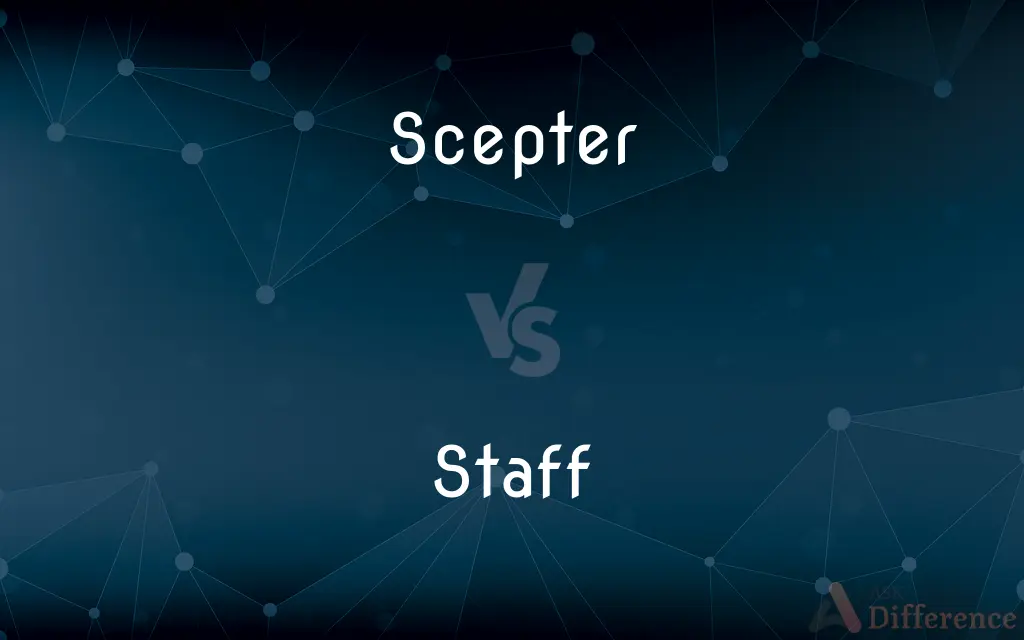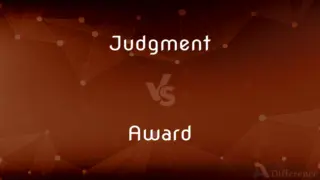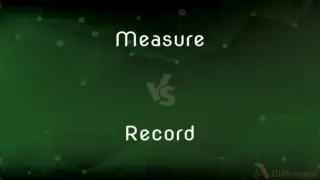Scepter vs. Staff — What's the Difference?
Edited by Tayyaba Rehman — By Urooj Arif — Updated on March 22, 2024
A scepter is a symbol of authority and sovereignty, often ornate, while a staff is a long, sturdy stick used for support, walking, or as a weapon.

Difference Between Scepter and Staff
Table of Contents
ADVERTISEMENT
Key Differences
A scepter, historically and symbolically, represents authority and royalty. It is an emblem carried by monarchs and deities to signify sovereign power and governance. Scepters are usually ornate, featuring jewels and intricate designs that reflect the status of the wielder. On the other hand, a staff is a practical tool that serves various purposes, from aiding in walking to serving as a weapon or a symbol of office in different cultural contexts. Staves are typically longer, designed for physical support or ceremonial use, and lack the ornate decoration of scepters.
Scepters are made from precious metals and adorned with gemstones, emphasizing the wealth and power of the owner. Their design is often specific to a particular culture or dynasty, carrying deep symbolic meaning. In contrast, staves are crafted from wood or metal and are valued for their durability and utility. While some staves, like those used in religious or magical contexts, may bear symbolic carvings or decorations, they generally prioritize function over form.
The use of a scepter is almost exclusively ceremonial, serving as a visual cue of authority during official events, coronations, and state functions. It is a key part of regalia, complementing crowns, robes, and other symbols of status. Conversely, the staff's use spans from the mundane, such as hiking or walking, to the ceremonial, where it may symbolize authority or spiritual power, but in a more utilitarian or symbolic than purely decorative manner.
In literature and mythology, the scepter often appears as a powerful artifact, imbuing its holder with the right to rule or command supernatural forces. It is a symbol of divine or absolute power, rarely used outside the context of sovereignty. Staffs, however, are common in tales of adventure and magic, symbolizing wisdom, guidance, or power. They are often attributed to travelers, wizards, and pilgrims, emphasizing their practical and mystical qualities.
Despite their differences, both scepters and staves hold significant cultural and symbolic value. The scepter emphasizes the ceremonial aspects of leadership and authority, while the staff underscores utility, support, and in some cases, magical or religious power. Their respective uses and designs reflect the roles they play in society, from the pinnacle of power to the everyday or the mystical.
ADVERTISEMENT
Comparison Chart
Primary Use
Symbol of authority and sovereignty
Support for walking, weapon, or symbol of office
Material
Precious metals and gemstones
Wood or metal
Design
Ornate, reflecting wealth and status
Functional, may have symbolic carvings
Context of Use
Ceremonial, in events like coronations
Varied, from everyday use to ceremonial purposes
Symbolism
Power, governance, and royalty
Guidance, wisdom, or authority; practicality
Compare with Definitions
Scepter
Often ornate, featuring jewels and intricate designs.
The king's scepter, adorned with diamonds, was a masterpiece of craftsmanship.
Staff
Made from wood or metal, prioritizing durability.
Her walking staff, carved from oak, had accompanied her on many journeys.
Scepter
Used in official ceremonies.
During the coronation, the monarch is presented with a scepter as part of the regalia.
Staff
Symbolizes wisdom or authority in myths.
The wizard's staff, imbued with magical properties, was a source of his power.
Scepter
A ceremonial object symbolizing sovereign power.
The queen held the golden scepter as a sign of her authority.
Staff
Versatile, used for practical and ceremonial purposes.
The leaders of the council each carried a staff as a token of their office and responsibility.
Scepter
Represents divine or absolute power in literature.
The ancient scepter, said to hold the power of the gods, was the kingdom's most guarded treasure.
Staff
May bear symbolic carvings or decorations.
The priest's staff was engraved with symbols that represented his spiritual journey.
Scepter
Specific to cultures or dynasties.
The scepter's design varied from one empire to another, each with its unique symbolism.
Staff
A long, sturdy stick used for support or as a weapon.
The traveler leaned on his staff as he climbed the mountain.
Scepter
A staff held by a sovereign as an emblem of authority.
Staff
A stick or cane carried as an aid in walking or climbing.
Scepter
Ruling power or authority; sovereignty.
Staff
A stout stick used as a weapon; a cudgel.
Scepter
To invest with royal authority.
Staff
A pole on which a flag is displayed; a flagstaff.
Scepter
Alternative form of sceptre
Staff
A rod or baton carried as a symbol of authority.
Scepter
Alternative form of sceptre
Staff
Pl. staffs A rule or similar graduated stick used for testing or measuring, as in surveying.
Scepter
A staff or baton borne by a sovereign, as a ceremonial badge or emblem of authority; a royal mace.
And the king held out Esther the golden scepter that was in his hand.
Staff
A group of assistants to a manager, executive, or other person in authority.
Scepter
Hence, royal or imperial power or authority; sovereignty; as, to assume the scepter.
The scepter shall not depart from Judah, nor a lawgiver from between his feet, until Shiloh come.
Staff
A group of military officers assigned to assist a commanding officer in an executive or advisory capacity.
Scepter
To endow with the scepter, or emblem of authority; to invest with royal authority.
To Britain's queen the sceptered suppliant bends.
Staff
The personnel who carry out a specific enterprise
The nursing staff of a hospital.
Scepter
The imperial authority symbolized by a scepter
Staff
Something that serves as a staple or support.
Scepter
A ceremonial or emblematic staff
Staff
(Music) A set of horizontal lines and intermediate spaces used in notation to represent a sequence of pitches, in modern notation normally consisting of five lines and four spaces. Also called stave.
Staff
A building material of plaster and fiber used as an exterior wall covering of temporary buildings, as at expositions.
Staff
To provide with a staff of workers or assistants.
Staff
To serve on the staff of (an organization).
Staff
A long, straight, thick wooden rod or stick, especially one used to assist in walking.
Staff
A series of horizontal lines on which musical notes are written; a stave.
Staff
The employees of a business.
The company employed 10 new members of staff this month.
The company has taken on 1600 more highly-paid staff.
Staff
(uncountable) A mixture of plaster and fibre used as a temporary exterior wall covering.W
Staff
A pole, stick, or wand borne as an ensign of authority; a badge of office.
A constable's staff
Staff
A pole upon which a flag is supported and displayed.
Staff
(archaic) The rung of a ladder.
Staff
A series of verses so disposed that, when it is concluded, the same order begins again; a stanza; a stave.
Staff
(engineering) An arbor, as of a wheel or a pinion of a watch.
Staff
(surgery) The grooved director for the gorget, or knife, used in cutting for stone in the bladder.
Staff
(military) An establishment of officers in various departments attached to an army, to a section of an army, or to the commander of an army. The general's staff consists of those officers about his person who are employed in carrying his commands into execution.
Staff
A form of token once used, in combination with a ticket, for safe train movements between two points on a single line.
Staff
(transitive) To supply (a business, volunteer organization, etc.) with employees or staff members.
Staff
A long piece of wood; a stick; the long handle of an instrument or weapon; a pole or stick, used for many purposes; as, a surveyor's staff; the staff of a spear or pike.
And he put the staves into the rings on the sides of the altar to bear it withal.
With forks and staves the felon to pursue.
Staff
A stick carried in the hand for support or defense by a person walking; hence, a support; that which props or upholds.
The boy was the very staff of my age.
He spoke of it [beer] in "The Earnest Cry," and likewise in the "Scotch Drink," as one of the staffs of life which had been struck from the poor man's hand.
Staff
A pole, stick, or wand borne as an ensign of authority; a badge of office; as, a constable's staff.
Methought this staff, mine office badge in court,Was broke in twain.
All his officers brake their staves; but at their return new staves were delivered unto them.
Staff
A pole upon which a flag is supported and displayed.
Staff
The round of a ladder.
I ascended at one [ladder] of six hundred and thirty-nine staves.
Staff
A series of verses so disposed that, when it is concluded, the same order begins again; a stanza; a stave.
Cowley found out that no kind of staff is proper for an heroic poem, as being all too lyrical.
Staff
The five lines and the spaces on which music is written; - formerly called stave.
Staff
An arbor, as of a wheel or a pinion of a watch.
Staff
The grooved director for the gorget, or knife, used in cutting for stone in the bladder.
Staff
An establishment of officers in various departments attached to an army, to a section of an army, or to the commander of an army. The general's staff consists of those officers about his person who are employed in carrying his commands into execution. See État Major.
Staff
Hence: A body of assistants serving to carry into effect the plans of a superintendent or manager; sometimes used for the entire group of employees of an enterprise, excluding the top management; as, the staff of a newspaper.
Staff
Plaster combined with fibrous and other materials so as to be suitable for sculpture in relief or in the round, or for forming flat plates or boards of considerable size which can be nailed to framework to make the exterior of a larger structure, forming joints which may afterward be repaired and concealed with fresh plaster.
Staff
Personnel who assist their superior in carrying out an assigned task;
The hospital has an excellent nursing staff
The general relied on his staff to make routine decisions
Staff
The body of teachers and administrators at a school;
The dean addressed the letter to the entire staff of the university
Staff
A strong rod or stick with a specialized utilitarian purpose;
He walked with the help of a wooden staff
Staff
Building material consisting of plaster and hair; used to cover external surfaces of temporary structure (as at an exposition) or for decoration
Staff
A rod carried as a symbol
Staff
(music) the system of five horizontal lines on which the musical notes are written
Staff
Provide with staff;
This position is not always staffed
Staff
Serve on the staff of;
The two men staff the reception desk
Common Curiosities
Can a staff be used as a scepter?
While a staff can symbolize authority or power, it is not traditionally used as a scepter because it lacks the ceremonial and ornate aspects associated with sovereignty.
Are scepters still used today?
Yes, scepters are still used in contemporary ceremonial events within monarchies and certain religious contexts to symbolize authority and power.
What materials are scepters made of?
Scepters are typically made from precious metals like gold or silver and adorned with gemstones to reflect the wealth and status of the wielder.
Are there any famous scepters or staves in history?
Many famous scepters and staves exist, such as the scepter of the British monarchy or the staffs carried by figures like Moses in biblical stories.
How does one acquire a scepter or staff?
A scepter is typically part of regalia and passed down through monarchies, while staves can be crafted, purchased, or inherited, depending on their purpose.
Do all cultures have scepters and staves?
Many cultures have objects that serve similar purposes to scepters and staves, symbolizing authority, power, or support, although their designs and uses may vary.
Can anyone carry a staff?
Yes, staves are used by people of all walks of life for various purposes, including support while walking, ceremonial functions, and as symbols of office in some traditions.
How are scepters and staves represented in mythology?
In mythology, scepters often symbolize divine or royal authority, while staves are associated with wisdom, guidance, and magical power.
Can staves be considered weapons?
Yes, staves have been used as weapons in various cultures, valued for their reach and the ability to be wielded with both speed and force.
Is the use of scepters limited to monarchies?
Primarily, yes, but scepters are also used in some religious ceremonies and organizations to symbolize authority and governance.
What is the significance of decorations on a scepter or staff?
Decorations on scepters signify wealth, status, and power, while decorations on staves can represent personal, spiritual, or cultural symbols.
What differentiates a magical staff from a regular one?
A magical staff is imbued with mythical powers in literature and folklore, distinguishing it from ordinary staves used for practical purposes.
How do scepters and staves symbolize authority differently?
Scepters symbolize authority through their association with sovereignty and divine right, while staves can represent authority in a more communal or spiritual sense.
Share Your Discovery

Previous Comparison
Judgment vs. Award
Next Comparison
Measure vs. RecordAuthor Spotlight
Written by
Urooj ArifUrooj is a skilled content writer at Ask Difference, known for her exceptional ability to simplify complex topics into engaging and informative content. With a passion for research and a flair for clear, concise writing, she consistently delivers articles that resonate with our diverse audience.
Edited by
Tayyaba RehmanTayyaba Rehman is a distinguished writer, currently serving as a primary contributor to askdifference.com. As a researcher in semantics and etymology, Tayyaba's passion for the complexity of languages and their distinctions has found a perfect home on the platform. Tayyaba delves into the intricacies of language, distinguishing between commonly confused words and phrases, thereby providing clarity for readers worldwide.















































